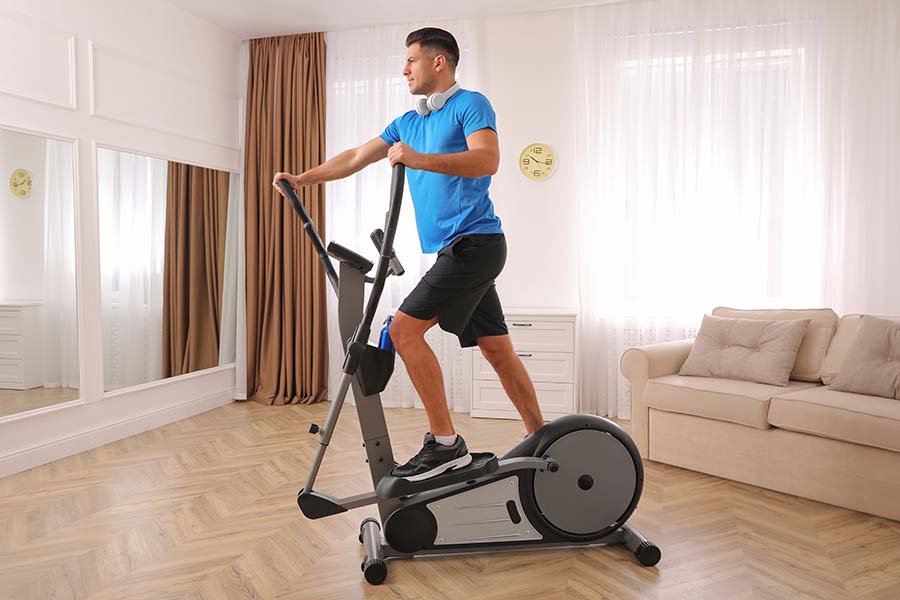Elliptical machines are a go-to for many fitness enthusiasts—low-impact, efficient, and easy to use. But if you've ever stepped off one feeling sore, unbalanced, or just unsure, you're not alone.
While these machines promise convenience, they can sometimes bring unexpected challenges. Whether it’s lingering discomfort or a sense that something feels “off,” it’s worth exploring what might be behind it.
Your commitment to health shouldn’t come with unnecessary setbacks. Understanding the potential downsides can help you adjust and move forward more confidently.
For added support during your sessions, consider using knee sleeves to enhance joint stability and reduce strain.
Potential Side Effects of Elliptical Machine
Elliptical machines offer a great cardio workout, but many users overlook their potential downsides. From minor discomfort to overuse injuries, it’s important to be aware.
In the section below, we’ll cover the most common side effects of elliptical training and what to watch out for during your workouts.
1. Limited Impact on Bone Density
Elliptical machines provide a low-impact workout, which makes them easier on the joints—but this also means they offer minimal benefit for improving bone density. They lack the mechanical stress needed to stimulate bone growth effectively.
To support stronger bones, consider incorporating high-impact exercises like running, jumping, or weight training. Additionally, a balanced diet and supplements such as Vitamin D3 with K2 can play a key role in maintaining bone health.
2. Ineffective for Building Muscle
Elliptical machines are primarily designed for cardiovascular workouts, offering low- to moderate-intensity movement. While they help increase heart rate and burn calories, they don’t provide the resistance needed to effectively stimulate muscle growth. Learn more about proper strength training in our muscle-building workouts guide.
To build muscle mass, focus on resistance training and consider supporting your efforts with supplements. An elliptical can help maintain muscle endurance, but it won’t drive significant growth on its own.
3. May Lead to Poor Workout Habits
While ellipticals can be effective for cardiovascular fitness, using them without proper guidance may lead to poor workout habits. Relying on the same intensity or duration every session can result in overtraining, reduced progress, and eventual burnout.
Improper form or hand placement can also cause mucle imbalances and increase joint strain over time. To prevent these issues, it’s essential to learn and maintain proper technique and vary your workout routine for balanced results.
4. Repetitive and Mentally Draining
Elliptical workouts can become monotonous over time due to their repetitive motion and lack of changing scenery. This can make it challenging to stay motivated and maintain a consistent routine.
To keep things engaging, explore different programs or intensity settings on your elliptical. You can also add variety by mixing in strength training, running, or even cycling. A diverse workout plan helps prevent boredom and supports long-term fitness success.
5. May Aggravate Existing Injuries
Although ellipticals offer a low-impact workout, they can still pose risks—especially for those with pre-existing injuries or medical conditions. Without proper form or caution, the repetitive motion can strain sensitive joints or muscles.
If you’re recovering from an injury or managing a condition, it’s important to listen to your body and avoid pushing too hard. Always consult with a medical professional before beginning any new exercise routine to ensure it’s safe and appropriate for your needs.
6. Can Worsen the Knee Pain
Using an elliptical machine can worsen some conditions rather than alleviate them. For instance, if you have a leg injury, the forced movement of the machine can damage your joints as you unnaturally swing your feet.
An elliptical workout could sometimes cause or worsen knee pain [1]. So be cautious if you have an underlying knee condition.
7. Not Ideal for Small Spaces
Elliptical machines are often large and bulky, making them challenging to fit into small living areas. Before purchasing, it’s important to ensure you have adequate space for both the machine and safe movement around it.
While they don’t require electricity, their size alone can be a drawback in compact homes. Always measure your available space before investing.
8. Limited Adjustability
Many ellipticals lack full adjustability, which can be uncomfortable for users on either end of the height spectrum. Taller individuals may slouch, while shorter users might experience strain in the neck or shoulders.
To avoid poor posture and potential discomfort, choose a model with adjustable stride length or ergonomically designed handles suited to your height.
9. Can Feel Repetitive
Elliptical workouts can become dull if performed without variation. Repeating the same motion daily may lead to boredom and reduced motivation over time.
To keep things interesting, try interval training, increase resistance, or set specific workout goals based on METs. Engaging the handles properly can also activate upper body muscles and improve overall results.
10. High Upfront Cost
Quality elliptical machines often come with a steep price tag, which may not be ideal for those on a tight budget. While they offer excellent cardiovascular benefits, the investment can be significant.
If budget is a concern, explore more affordable alternatives like resistance bands, jump ropes, or bodyweight circuits that still deliver solid cardio benefits without breaking the bank.
How to Reduce the Risk of Potential Elliptical Side Effects
While elliptical machines offer a low-impact workout, they’re not entirely risk-free. Fortunately, with a few simple adjustments and mindful habits, you can significantly reduce the chance of discomfort or injury. Below are practical tips to help you get the most from your workouts—safely and effectively.
1. Maintain Proper Technique and Posture
Using poor form on the elliptical can lead to joint discomfort, muscle strain, and even long-term injury. Keep your spine straight, engage your core, and avoid leaning too heavily on the handles to ensure balance and control.
Stay focused on smooth, controlled movements. Wearing proper gear and ensuring a steady grip will also help you maintain stability throughout your session.
2. Increase Intensity Gradually
Jumping into high resistance or long sessions too quickly can strain your muscles and increase the risk of injury. Begin with low resistance and shorter durations, then gradually build up as your endurance improves.
Structuring your workouts with intervals and allowing time for recovery will help your body adapt safely and reduce the risk of overtraining.
3. Stretch and Warm Up Before Every Session
Skipping a proper warm-up can increase your risk of tight muscles and preventable injuries. Begin with light cardio or mobility drills to increase blood flow and prepare your joints for movement.
Incorporate dynamic stretching before your workout and static stretches afterward to enhance flexibility and reduce post-exercise stiffness.
4. Alternate Elliptical Workouts with Other Exercises
Relying solely on the elliptical for cardio can lead to repetitive strain and muscle imbalances over time. Switching up your routine with different activities helps prevent overuse injuries and keeps your workouts engaging.
Incorporate strength training, yoga, or other forms of cardio to target different muscle groups, improve overall performance, and support long-term fitness goals.
Related Article: Best Indoor Cardio Exercises to Become Stronger & More Energetic As You Age
FAQs
1. What are the drawbacks of using an elliptical?
Ellipticals can feel unfamiliar or awkward for beginners without proper instruction. They offer a limited range of motion compared to free weights or bodyweight exercises, which may make it harder to engage certain muscle groups or perform varied movements.
2. Which is better for your health: the treadmill or the elliptical?
Treadmills generally offer a more intense aerobic workout. Some studies have shown that treadmill users may burn more fat compared to those using ellipticals. However, ellipticals are gentler on the joints, making them a safer option for individuals with knee or hip concerns.
3. Can elliptical workouts cause nerve damage?
In rare cases, prolonged use of an elliptical may irritate nerves in the foot, particularly between the third and fourth toes, due to constant foot pressure on the pedals. To reduce this risk, avoid excessive incline settings and take breaks when needed.
4. Is the elliptical machine better than walking?
Elliptical machines typically burn more calories than walking and offer a low-impact alternative that’s easier on the joints. For example, a 160-pound person may burn around 365 calories per hour on an elliptical, compared to 314 calories while walking at a moderate pace.
Takeaway
Elliptical machines offer a convenient and low-impact way to improve cardiovascular health, making them a popular choice for many fitness enthusiasts. However, like any equipment, improper use or lack of variation can lead to discomfort or setbacks. Awareness of the potential side effects is the first step toward using the machine more effectively and safely.
By focusing on proper technique, gradually increasing intensity, incorporating variety, and using supportive accessories when needed, you can maximize the benefits of elliptical training while minimizing risks. Stay consistent, listen to your body, and aim for a balanced routine that supports long-term wellness.
Reading List
Article Sources
- [1] Hummer, Erik T., et al. "Movement Direction Impacts Knee Joint Kinematics during Elliptical Exercise at Varying Incline Angles." The Knee, vol. 29, Mar. 2021, pp. 201 - 07. ScienceDirect. DOI: https://www.sciencedirect.com/science/article/abs/pii/S0968016021000521.














